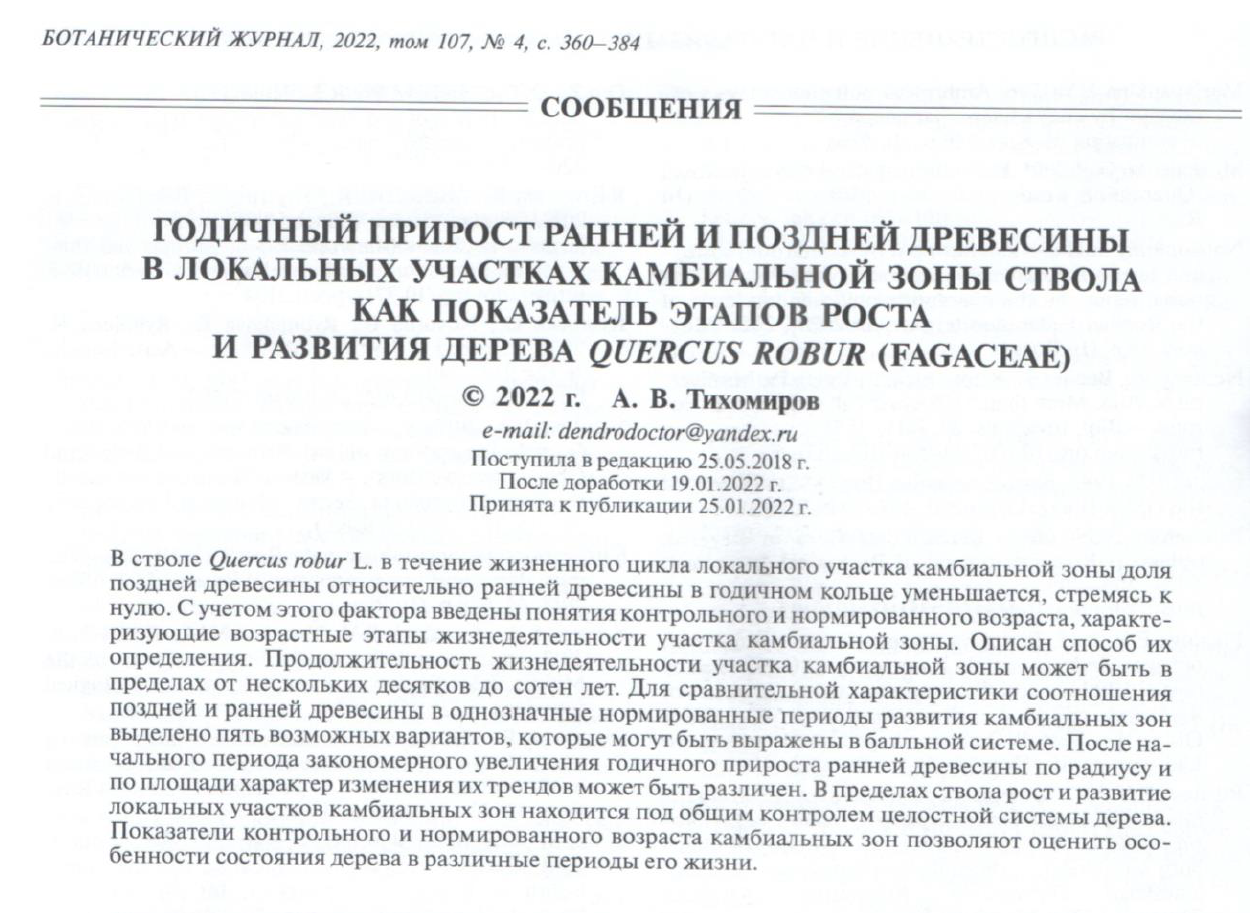Годичный прирост ранней и поздней древесины в локальных участках камбиальной зоны ствола как показатель этапов роста и развития дерева Quercus robur (Fagaceae)
Годичный прирост ранней и поздней древесины в локальных участках камбиальной зоны ствола как показатель этапов роста и развития дерева Quercus robur (Fagaceae)
Ботанический журнал. 2022, Том 107. № 4, с. 360—384
УДК:, ББК:, ISBN:DOI: 10.31857/S000681362204007X
В стволе Quercus robur L. в течение жизненного цикла локального участка камбиальной зоны доля поздней древесины относительно ранней древесины в годичном кольце уменьшается, стремясь к нулю. С учетом этого фактора введены понятия контрольного и нормированного возраста, характеризующие возрастные этапы жизнедеятельности участка камбиальной зоны. Описан способ их определения. Продолжительность жизнедеятельности участка камбиальной зоны может быть в пределах от нескольких десятков до сотен лет. Для сравнительной характеристики соотношения поздней и ранней древесины в однозначные нормированные периоды развития камбиальных зон выделено пять возможных вариантов, которые могут быть выражены в балльной системе. После начального периода закономерного увеличения годичного прироста ранней древесины по радиусу и по площади характер изменения их трендов может быть различен. В пределах ствола рост и развитие локальных участков камбиальных зон находится под общим контролем целостной системы дерева. Показатели контрольного и нормированного возраста камбиальных зон позволяют оценить особенности состояния дерева в различные периоды его жизни.
| Размещено: | 15 Ноября 2022 г. |
| Предоставлено: | Кавказский государственный природный биосферный заповедник |
Annual increment of earlywood and latewood in local portions of cambial zone as indicator of the stages of tree growth and development of Quercus robur (Fagaceae) trunk
ISBN:DOI: 10.31857/S000681362204007X
The latewood/earlywood ratio in the annual ring of the Quercus robur L. trunk reduces towards zero through the lifetime of a local portion of the cambial zone. The latewood/earlywood radial annual increments ratio is used to characterize such phenomena within the local cambium portion. With its value 0.4, the greatest probability of the tree drying is observed. Accordingly, the term “control age” was introduced, i.e. the age of the annual ring with latewood/earlywood ratio 0.4. Furthermore, the term “annual ring normalized age” was introduced, defined as the relationship between the specific annual ring and the control age. The cambium portion lifespan may vary from several dozens to several hundreds of years. The normalized age allows to analyze cambium zones in similar periods of their development. Meanwhile, the latewood/earlywood ratio of different cambium zones may vary several-fold. In order to analyze them, five types of proportion between the increment ratio and the normalized age, which may be defined in a scoring system, were distinguished. A comparative analysis of the earlywood annual increment formation in terms of radius and area was conducted. Following the initial periods of the earlywood regular annual increment increase in terms of radius and area, their trend behavior may be different. During this period, the earlywood radial increment decreases but the area increment, depending on this decrease intensity, may increase, remain constant or decrease. The analysis of the control age in the local cambium portions at the various trunk height shows that cambium zones through the tree life can be at different stages of their development, but generally they are controlled by the overall ontogenesis rate. The indicators of cambium zones control/normalized age allow to evaluate characteristics of the tree condition it different times of its life.
| Published: | 15 November 2022 |
| Provided: | Caucasus Nature Biosphere Reserve |
36просмотров
20скачиваний
